Click image for BBB rating
See our Privacy Policy
cool="cool" width="784" height="9714" border="0" cellpadding="0" cellspacing="0" gridx="16" showgridx="showgridx" usegridx="usegridx" gridy="16" showgridy="showgridy" usegridy="usegridy" bgcolor="#99ccff">
|
|
|
 |
|
|
|
|
|
|
Welcome to Spaightwood Galleries, Inc.
120 Main Street, Upton MA 01568-6193
You can follow us on Facebook and Twitter!
We blog regularly on Facebook and announce special events and special sales on both sites.
|
|
|
|
|
|
For Catholics during the middle ages and the Renaissance, the Crucifixion was an ever-recurring event: with each newly-committed human sin, Jesus suffered and died yet again (for an early twentieth-century version of this belief, click here to see Georges Rouault's Miserere 35, "Jésus sera en agonie jusqu'a la fin du monde" / "Jesus will be in agony, even to the end of the world"; the title, significantly, comes from the 17th-century French philosopher Blaise Pascals' Pensées). The image of Christ on the cross is everywhere in Medieval and Renaissance art, yet the use of those images could be suspect. If it was intended merely to raise pathos, the images should be rebuked (as Michelangelo, who himself made some ravishing drawings of the Crucifixion, rebuked the all-too-realstic depictions of the Crucifixion in 15th- and early 16th-century Netherlandish art) and as Protestant iconoclasts in those parts of Germany where Lutheranism triumphed, in the Netherlands, and in England, demonstrated when they attempted to purge their churches of these relics of superstitious adoration. Yet at the same time these lovers of St. Paul's Epistles were also fixated on what was for them the meaning of the Crucifixion and for what we need to learn about ourselves from contemplating it: As St. Paul wrote in his first epistle to the Corinthians, "the message about the cross is foolishness to those who are perishing, but to us who are being saved it is the power of God. For it is written, 'I will destroy the wisdom of the wise, and the discernment of the discerning I will thwart.' Where is the one who is wise? Where is the scribe? Where is the debater of this age? Has not God made foolish the wisdom of the world? For since, in the wisdom of God, the world did not know God through wisdom, God decided, through the foolishness of our proclamation, to save those who believe. For Jews demand signs and Greeks desire wisdom, but we proclaim Christ crucified, a stumbling block to Jews and foolishness to Gentiles, but to those who are the called, both Jews and Greeks, Christ the power of God and the wisdom of God. For God’s foolishness is wiser than human wisdom, and God’s weakness is stronger than human strength. Consider your own call, brothers and sisters: not many of you were wise by human standards, not many were powerful, not many were of noble birth. But God chose what is foolish in the world to shame the wise; God chose what is weak in the world to shame the strong; God chose what is low and despised in the world, things that are not, to reduce to nothing things that are, so that no one might boast in the presence of God. He is the source of your life in Christ Jesus, who became for us wisdom from God, and righteousness and sanctification and redemption, in order that, as it is written, 'Let the one who boasts, boast in the Lord.' (I Corinthians 1: 18-31). In the "fact" of the Crucifixion–for Protestants an act in historical time that happened for a purpose and has fulfilled its purpose–to repair the rent in humanity's relationship with God and thus to accomplish the salvation of those who are called to believe. God, to reconcile man to God, died the death promised in Genesis to those who disobeyed God's command not to eat from the Tree of the Knowledge of Good and Evil and thus enabled eternal life to be restored to those chosen by God. The use of the Cross, for Erasmus, especially in his most popular work, the Encomium Moriae or The Praise of Folly was to force readers to set aside reason and turn to God through faith, something that explains its great popularity in Protestant countries (John Milton in a letter from college to his father tells him that everyone at Cambridge written in the early 1620s is reading the work) contrasts with its presence, post Council of Trent, on the Catholic Index of Forbidden Books.
|
|
|
|
|
 |
|
|
|
Albrecht Durer (Nuremburg, 1471-1528), Christ Carrying the Cross from the Large Woodcut Passion (Bartsch 10, Srauss 64, Meder 119). Original woodcut, c. 1498-1499. A superb Meder a proof impression before the 1511 Latin text edition. Several repaired edge tears. Strauss calls this the "most dramatic of the sheets of the large Passion" and notes that "instead of seeming to be crushed by the weight of the Cross, as in the earlier versions, Durer's Christ seems to stop only for breath"; Christ turns to St. Veronica, who is offering her kerchief. On the upper left, St. John helps the Virgin Mary as she follows; an unidentified one of the holy women is behind the Virgin. Image size: 392x282mm. Price: Please call or email for current pricing information.
|
|
|
|
|
|
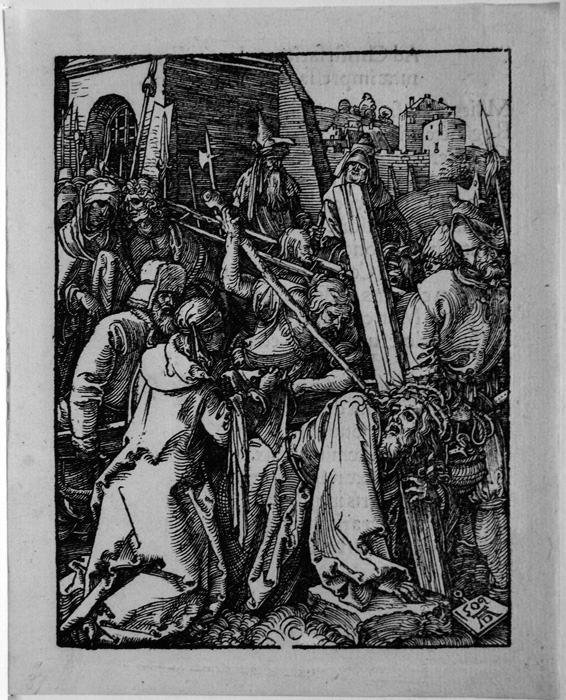 |
|
|
|
|
Christ Carrying the Cross (B. 37, S. 122). Original woodcut, 1509. A brilliant impression from the 1511 first edition with the Latin text on the verso printed on laid paper with an unreadable partial watermark and with wide margins. Strauss says, "Of all Durer's versions of this subject, this is the most remarkable. The emphasis is on the Savior's supporting arm, as if his body was suspended from it. A great effort on his part is required to turn his head, as he looks with an expression of helplessness at Veronica tendering her kerchief. It is no longer the pose of Orpheus, as in the Large Passion (no. 59), nor yet the erect figure, symbolizing the the spiritual relationship between the Son of God, and the believer, of the later engraved version" (p. 374). Signed & dated in the block. Meder's description of this woodcut precisely matches our print: "clear and flawless; a big gap lower center; a split upper right" (Strauss, p. 374). Comparing this impression with the other impression from the 1511 edition shown below, the split at the top right appears to be smaller on this impression, suggesting that it is a slightly earlier impression than the one below. One of the greatest prints of the Renaissance. Image size: 127x96mm. Price: Please call or email for current pricing information.
For the text on the verso, see below.
|
|
|
|
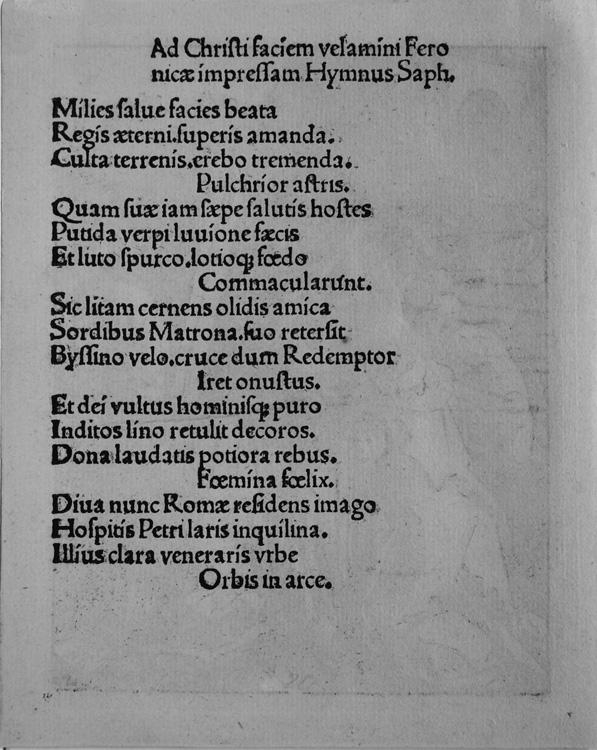 |
|
Christ Carrying the Cross (B. 37, S. 122). Original woodcut, 1509. A brilliant impression from the 1511 first edition with the Latin text on the verso printed on laid paper with an unreadable partial watermark and with wide margins. The text type and layout exactly match those reproduced in the reduced-size facsimile of the 1511 Small Woodcut Passion by Horst Appuhn, Die Kleine Passion von Albrecht Dürer (Dortmund: Harenberg, 1985), p. 52.
|
|
|
|
|
|
 |
|
Christ Carrying the Cross (B. 37, S. 122). Original woodcut, 1509. In 1844 plaster casts were made from Durer's original woodblocks for the Small Woodcut Passion, which had just been acquired by the British Museum. From these casts, metal plates were made and a small edition produced. Our impression is from this edition. Strauss says, "Of all Durer's versions of this subject, this is the most remarkable." Christ turns to St. Veronica, who is offering her kerchief, with a look of helplessness. On the upper left, St. John helps the Virgin Mary as she follows; an unidentified one of the holy women is behind the Virgin. Signed & dated in the block. One of the greatest prints of the Renaissance. For a very different interpretation, see Durer's woodcut for the Large Passion. See also the commentary upon it in Strauss. Image size: 127x96mm. Price: Please call or email for current pricing information.
|
|
|
|
|
|
|
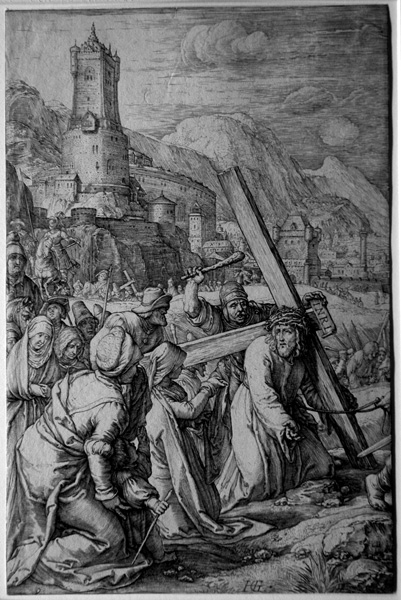 |
|
Hendrik Goltzius (Dutch, 1558-1617), Christ bearing the Cross (Bartsch 35, Hirschmann 29, Strauss 353 i/ii). Original engraving, 1598. A very good impression on laid paper of the first state of two; trimmed on or within the platemark. Signed in the plate, numbered bottom left margin. Ex collection John S. Philips, The Pennsylvania Academy of Fine Arts (with their PAFA stamp verso), and the Philadelphia Museum of Art, who received it as part of their purchase of the PAFA collection and offered it for sale as surplus. Strauss observes that Goltzius' inventiveness reaches a high point here, where in contrast to all of the other versions Goltzius knew, Christ here almost looks as if he is leading a parade, and pausing only to look at St. Veronica. Image size: 197x130mm. Price: Please call or email for current pricing information.
|
|
|
|
|
|
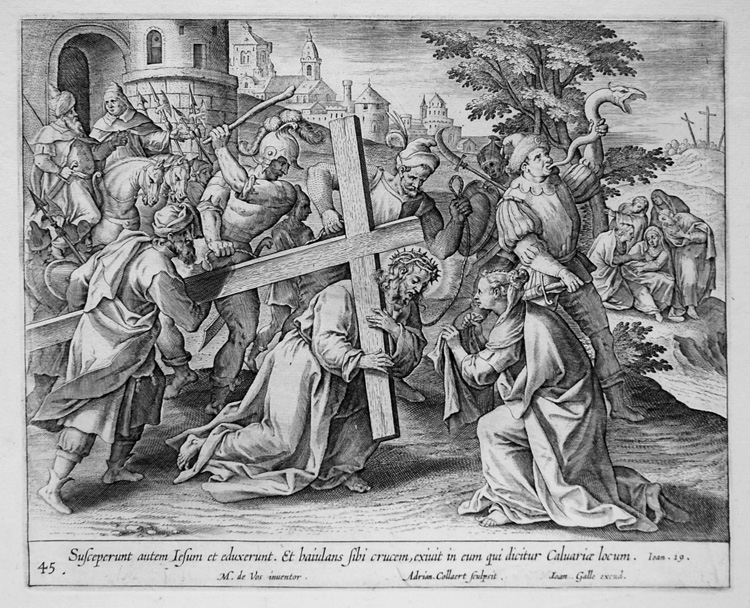 |
|
|
Adrien Collaert (Antwerp, c. 1560-1618), Christ carrying the Cross and the Miracle of Veronica's Sudarium (New Hollstein 218iv/iv), Engraving after Maarten de Vos, 1598. Number 45 of a series of 51 engravings on The Life, Passion and Resurrection of Christ. Our impression is from the 4th state published by Joan Galle in 1638. The series was very popular and printed several times by itself and used as well in other series, including the Theatricum Biblicum (1643). Ours is a very good impression with wide margins in very fresh condition. Image size: 180x220mm. Price: Please call or email for current pricing information.
|
|
|
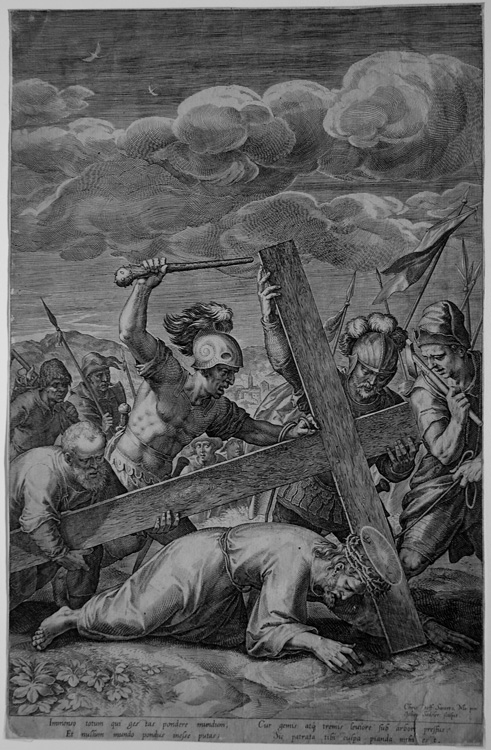 |
|
|
|
Jan Sadeler (Dutch, 1550-1600), Christ falling under the Cross (TIB 70.200). Engraving after Christoph Schwartz (Munich, c. 1548-1592), Court Painter to Duke William V of Bavaria, who was highly sought after in Germany and by Emperor Rudolf II for his religious paintings. When Hendrick Goltzius visited Munich in 1591 he drew a portrait of Schwarz. Engravings by Jan Sadeler I and Aegidius Sadeler II, Lucas Kilian and others, and above all the approval expressed by Sandrart, kept the reputation Schwarz had enjoyed in his lifetime alive well into the 18th century. A very good impression on laid paper of this large engraving, part of a series of eight engravings on the Passion emphasizing its brutality (ours appears to be a darker impression than the one illustrated in The Illustrated Bartsch). Signed in the plate lower right: "Christoff Swartz Mo. {Munich] pinxit" and "Joann: Sadeler Scalpit" at the bottom right margin. There is a diagonal crease top right, a tear bottom right margin going through the verses below the image, three small paper losses in Jesus' forehead, left arm, and right wrist, and a paper loss in the bottom left corner not affecting the image. Trimmed on or within the platemark. Image size: 431x279mm. Price: Please call or email for current pricing information.
|
|
|
|
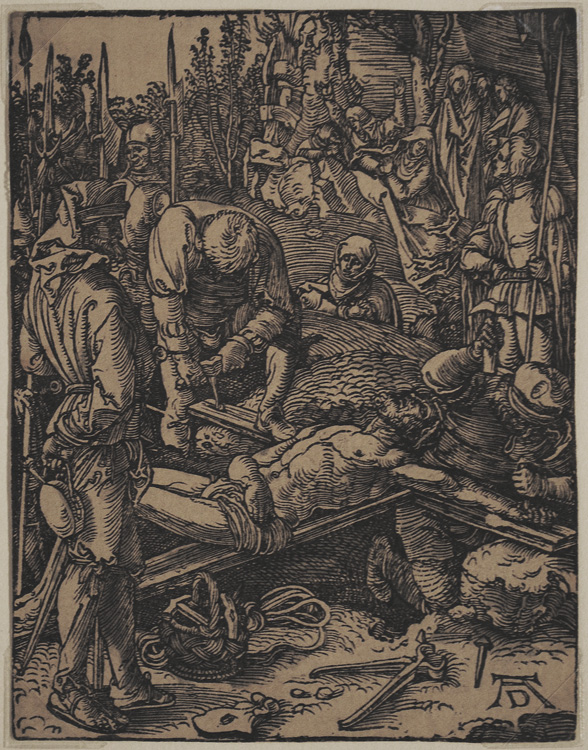 |
|
|
|
|
|
Christ nailed to the Cross (B. 39, S. 123, Meder 148 without text a). Original woodcut, c. 1509. The darkness that occurred from noon to three according to Matthew 28: 47 has begun. The executioner on the right is nailing Jesus' left hand to the cross, the other hand still lies about his waist. Immediately to the rear of Jesus, one of the women appears to be praying, another wrings her hands together, St. John seems to be trying to comfort another, probably Jesus' mother. The image has been trimmed on or within the left border; there are some losses to the top border and on the right border; the bottom border is mostly intact. Overall, this is a very strong impression made very soon after the 1511 Latin first edition. Image size: 126x95mm. Price: Please call or email for current pricing information.
|
|
|
|
|
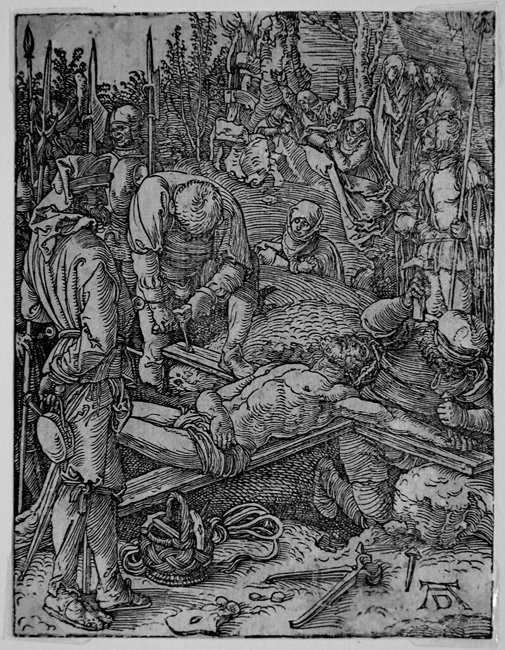 |
|
Christ nailed to the Cross (B. 39, S. 123, Meder 148 without text a). Original woodcut, c. 1509. The darkness that occurred from noon to three according to Matthew 28: 47 has begun. The executioner on the right is nailing Jesus' left hand to the cross, the other hand still lies about his waist. Immediately to the rear of Jesus, one of the women appears to be praying, another wrings her hands together, St. John seems to be trying to comfort another, probably Jesus' mother. The image has been trimmed within the border and top and on the sides; the bottom border is mostly intact except for three small gaps. The lower right corner has a repaired tear. Overall, this is a strong impression made fairly soon after the 1511 Latin first edition. Image size: 126x97mm. Price: Please call or email for current pricing information.
|
|
|
|
|
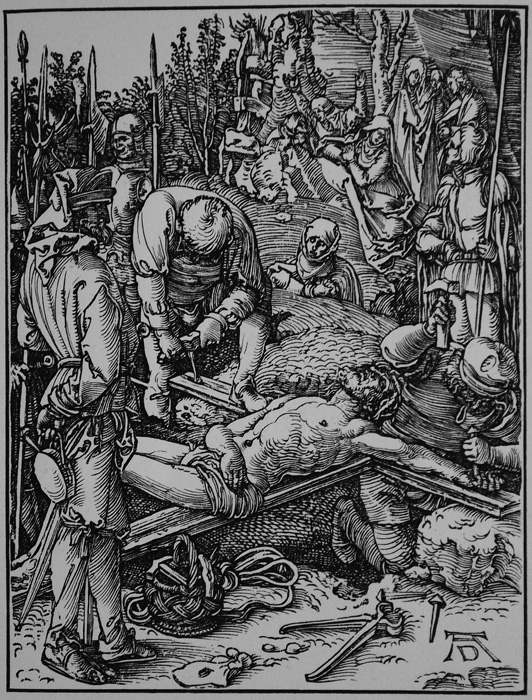 |
|
Christ nailed to the Cross (B. 39, S. 123, Meder 148). Original woodcut, c. 1509. The darkness that occurred from noon to three according to Matthew 28: 47 has begun. The executioner on the right is nailing Jesus' left hand to the cross, the other hand still lies about his waist. Immediately to the rear of Jesus, one of the women appears to be praying, another wrings her hands together, St. John seems to be trying to comfort another, probably Jesus' mother. In 1844 plaster casts were made from Durer's original woodblocks for the Small Woodcut Passion, which had just been acquired by the British Museum. From these casts, metal plates were made and a small edition produced. Our impression is from this edition. Image size: 126x97mm. Price: Please call or email for current pricing information.
|
|
|
|
|
|
|
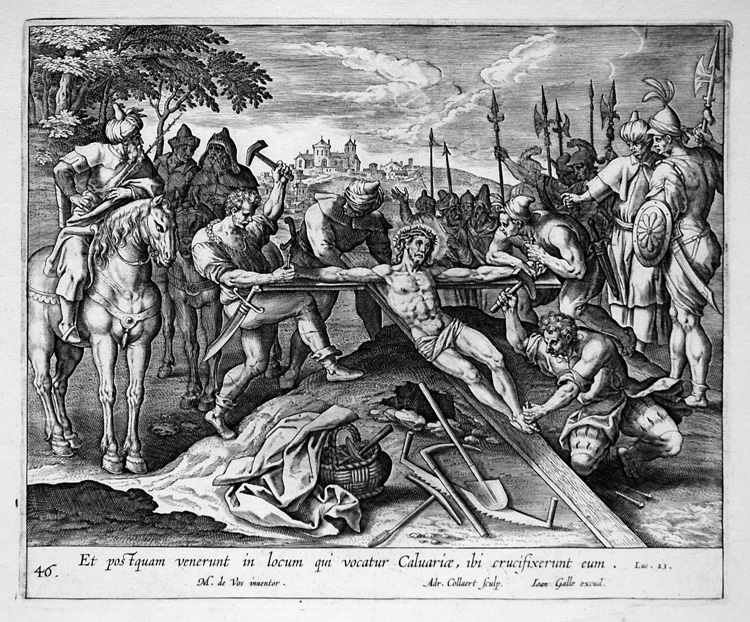 |
|
|
Adrien Collaert (Antwerp, c. 1560-1618), Christ nailed to the Cross (New Hollstein 219iv/iv), Engraving after Maarten de Vos, 1598. Number 46 of a series of 51 engravings on The Life, Passion and Resurrection of Christ. Our impression is from the 4th state published by Joan Galle in 1638. The series was very popular and printed several times by itself and used as well in other series, including the Theatricum Biblicum (1643). Ours is a very good impression with wide margins in very fresh condition. Image size: 180x220mm. Price: Please call or email for current pricing information.
|
|
|
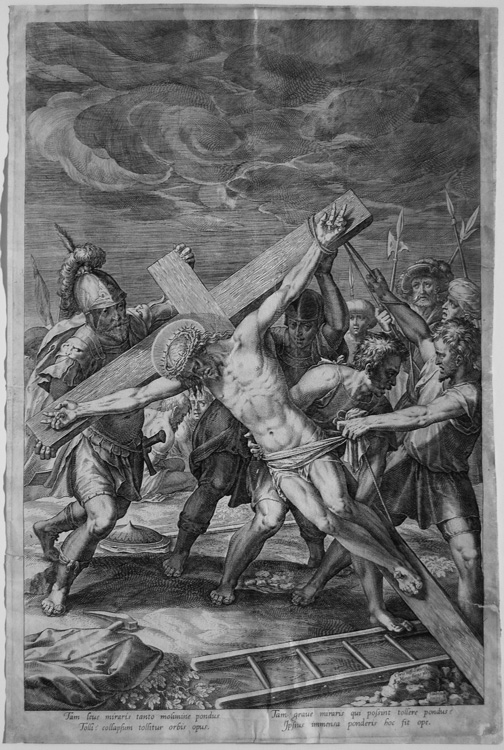 |
|
|
|
Jan Sadeler (Dutch, 1550-1600), The Raising of the Cross (TIB 70.202). Engraving after Christoph Schwartz. A very good impression on laid paper of this large engraving, part of a series of eight engravings on the Passion. Signed in the plate lower right: "Christoff Swartz monachiens pix" on the large rock lower right and "J.Sadeler Scalpit" on the small rock at the bottom right margin. There is a crease top center (which is reflecting light), a tear lower right below the knee of the soldier pulling against Jesus' clothes, and a small abrasion in the extreme right corner just above the platemark. Thread margins on the top, bottom, and left side, the right side irregularly trimmed into the margin right edge, else thread margins there as well. Image size: 441x292mm. Price: Please call or email for current pricing information.
|
|
 |
|
|
|
|
|
|
The Crucifixion (B. 40, S. 124) Original woodcut, c. 1509 for the Small Passion. Strauss observes that Dürer "has relegated St. John to a place in the background, behind the group of the Holy Women. He concentrates on the figure of the Magdalen, in the foregound, on her knees, who symboliizes extreme grief in a stance that is imediately comprehensible to the widest possible audience" (Strauss, Woodcuts, p. 378). A good 16th-century impression without text after the first edition with margins outside the border. The block has been chipped in the lower left corner and at the top border at left and center. Some wear, but still printing darkly. Image size: 127x97mm. Price: Please call or email for current pricing information.
|
|
|
|
|
|
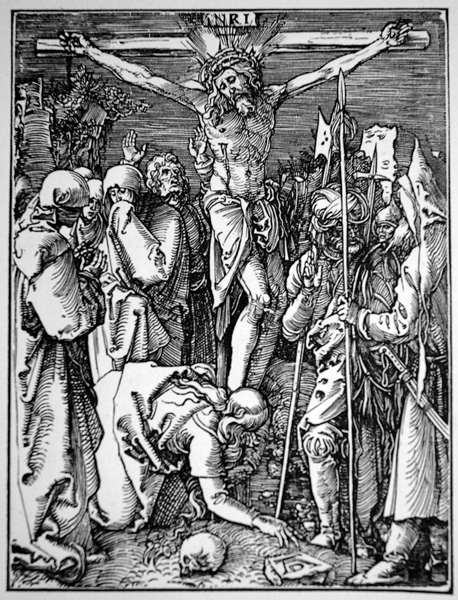 |
|
The Crucifixion (B. 40, S. 124) Original woodcut, c. 1509 for the Small Passion. Strauss observes that Dürer "has relegated St. John to a place in the background, behind the group of the Holy Women. He concentrates on the figure of the Magdalen, in the foregound, on her knees, who symboliizes extreme grief in a stance that is imediately comprehensible to the widest possible audience" (Woodcuts, p. 378). In 1844 plaster casts were made from Durer's original woodblocks for the Small Woodcut Passion, which had just been acquired by the British Museum. From these casts, metal plates were made and a small edition produced. Our impression is from this edition. Image size: 127x98mm. Price: Please call or email for current pricing information.
|
|
|
|
|
|
 |
|
|
|
Georg Pencz (German, 1500-1550), Christ on the Cross (Bartsch 57). Original engraving, 1547. A very good impression on laid paper with small margins outside the platemark. Signed in the plate with the monogram and dated. Pencz seems to have been in Dürer's workshop in the early 1520s. He is one of the most important "little masters," the generation of German printmakers who were strongly influenced by Albrecht Dürer and who tended to work in very small sizes. Image size: 115x80mm. Price: Please call or email for current pricing information.
|
|
|
|
Spaightwood Galleries, Inc.
To purchase, call us at 1-800-809-3343 (1-508-529-2511 in Upton MA & vicinity) or send an email to spaightwood@gmail.com.
We accept AmericanExpress, DiscoverCard, MasterCard, and Visa.
We also accept wire transfers and paypal.
For directions and visiting information, please call. We are, of course, always available over the web and by telephone (see above for contact information). Click the following for links to past shows and artists. For a visual tour of the gallery, please click here. For information about Andy Weiner and Sonja Hansard-Weiner, please click here. For a list of special offers currently available, see Specials.
All works are sold with an unconditional guarantee of authenticity (as described in our website listing).
Go back to the top of this page.
Visiting hours: Saturday 10:00 am to 5:00 pm and Sunday noon to 6:00 pm and other times by arrangement.
Please call to confirm your visit. Browsers and guests are welcome.
|
|
|
|
|
|
|
|
|
|
|
|
|
|
|
|
|
|
|
|
|
|
|
|
|
|
|
|
|
|
|
|
|
|
|
|
|
|
|
|
|
|
|
|
|
|
|
|














